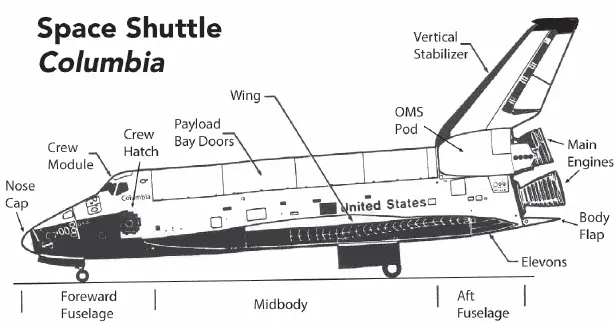And what a thrill it was to work with the space shuttle! It was a masterpiece of American technological prowess—the pinnacle of NASA’s manned spacecraft evolution. Each of the winged vehicles of the “Space Transportation System,” which we called the “orbiter” or just simply “the shuttle,” took off like a rocket from KSC and landed like a glider. Crews of up to seven astronauts [1] Challenger carried a crew of eight astronauts on the October/November 1985 flight of STS-61A. Atlantis also carried eight astronauts and cosmonauts on its return from the Russian Mir space station on STS-71 in 1995. Throughout the rest of the Space Shuttle Program, crew complement was limited to seven astronauts.
{1} 1 Except where otherwise noted, quotes and observations attributed to people throughout the book are taken from the authors’ interviews with those individuals. Other detailed information that is not footnoted is from Mike Leinbach’s personal notes and files.
could work in a spacious shirtsleeves environment for missions lasting as long as sixteen days, while the temperature in the vacuum of space just outside their windows ranged from 250°F in direct sunlight to minus 250°F in the shade. They could also venture outside through an air lock to perform space walks. The shuttle’s cargo bay carried payloads as large as a school bus.
Each orbiter—the size of a small commercial airliner—was lofted into Earth orbit bolted to an enormous external fuel tank and a pair of the most powerful solid propellant rocket boosters ever developed. The two solid rocket boosters turned 2.2 million pounds of fuel into energy—and speed—in the course of 127 seconds. The foam-covered fuel tank held about 1.6 million pounds of liquid oxygen and liquid hydrogen, which the shuttle’s three main engines gulped dry in the space of eight and one half minutes, by which time the shuttle was in orbit and traveling 17,500 mph. Everything in the system except for the external tank could be reused.
NASA’s shuttle fleet— Columbia , Challenger , Discovery , Atlantis , and Endeavour —flew 135 space missions between 1981 and 2011, carrying a total of 833 crew members. [2] Tariq Malik, “NASA’s Space Shuttle By the Numbers: 30 Years of a Spaceflight Icon,” Space.com, March, 9, 2011, www.space.com/12376-nasa-space-shuttle-program-facts-statistics.html .
Space shuttles took 3.5 million pounds of cargo into orbit during the Program. This included scores of different payloads—satellites, laboratories, planetary probes, NASA’s Great Observatories (such as the Hubble Space Telescope), experiments, and space station modules.
There had never been such an amazing flying machine.
It was also far from perfect.

In 1997, NASA announced plans for a sixteen-day research mission, STS-107. [3] Shuttle mission numbers were assigned based on their original order in the launch manifest. STS-107 was the 107th assigned flight in the Space Shuttle Program. Changes in launch priorities and availability of hardware occasionally changed the order in which the missions flew. STS-107 was the 113th shuttle mission to fly. In informal conversation, missions were usually just referred to by their number—in this case, “one-oh-seven.”
The new Spacehab double module, about the size of a school bus, would fly in the payload bay of Columbia , the flagship of the shuttle fleet. Spacehab was an orbital laboratory boasting a wide array of science and medical experiments, studying subjects as diverse from how various systems in the human body respond to weightlessness to how to grow protein crystals for cancer therapies. Spacehab was pressurized and connected to the shuttle’s cockpit by a tunnel, allowing the astronauts to operate the research equipment in a shirtsleeves environment. NASA announced the mission’s crew in July 2000.
United States Air Force Colonel Rick Husband was the mission commander and the man at the shuttle’s controls. He had served previously as pilot—the second-in-command, who does not actually fly the shuttle—on STS-96. He was one of very few astronauts to be given command of a mission after only one previous spaceflight. A deeply religious man, Husband was renowned for his sense of humor, ability to build cohesive teams, and beautiful singing voice.
Commander William “Willie” McCool, the mission’s pilot, was a US Navy test pilot and was on his first shuttle mission. His colleague Laurel Clark described him as a “ten-year-old trapped in the body of an eight-year-old” because of his boyish looks and youthful exuberance. [4] NASA, “Sixteen Minutes from Home: A Tribute to the Crew of STS-107,” KSC Web Studio (Kennedy Space Center, FL) video, February 2003.
Lieutenant Colonel Michael Anderson, USAF, served as payload commander for STS-107. He was a veteran of one previous shuttle mission and was the ninth African American to fly in space.
Kalpana “KC” Chawla, PhD, an aerospace engineer, was the first Indian-born woman in space. Flying on her second space mission, she was STS-107’s flight engineer.
Captain Dave Brown, MD, a naval aviator and naval flight surgeon, was a mission specialist on his first spaceflight. Brown was the only unmarried member of the crew.
Commander Laurel Clark, MD was, like Brown, a naval flight surgeon and a mission specialist on her first spaceflight.
Colonel Ilan Ramon, a fighter pilot in the Israeli Air Force, was the specialist operating an experiment to observe dust storms in the Mediterranean and Israel. He was Israel’s first astronaut, and this was his first space mission.
Between their selection and their flight, the crew spent more than 4,800 hours training for the mission and an additional 3,500 hours training to run the medical and scientific experiments in the Spacehab module. The many mission delays—thirteen in all, due to priority changes and hardware issues—enabled the crew to bond closely with one another. They spent nine nights camping in Wyoming as part of an outdoor leadership course in 2001. Brown carried a video camera everywhere to record the crew’s preparations and commemorate their friendship.
A mission’s commander sets the tone for how the crew interacts with the support teams on the ground. Some commanders were type A personalities—all business. Husband, on the other hand, was one of the warmest and most caring commanders imaginable. He, and by extension his crew, made everyone he worked with on the ground support teams feel like part of a family.
Robert Hanley, from Houston’s Johnson Space Center (JSC), served as the interface between the astronaut crew and the teams at Kennedy who were preparing Columbia for her mission. Hanley got to know the STS-107 crew and their families intimately during the two years leading up to the mission. He said, “Hands down, 107 was the best crew I ever had. They were just awesome individuals. Rick set the stage that ‘Hey, we’re gonna be a warm, happy, fun crew,’ and they were.”
Ann Micklos, the lead airframe engineer for Columbia at KSC, was responsible for structural issues and the thermal protection system on the orbiter. Apart from her official role working with the shuttle, she had a unique relationship with the crew—she and Dave Brown had been dating since before his assignment to STS-107. Their connection further strengthened the personal relationship between the ground crews and Columbia . Ann said, “It wasn’t just personal for me. It was personal for everyone who was working on that vehicle—they all knew me and knew I was dating Dave.”
Читать дальше












